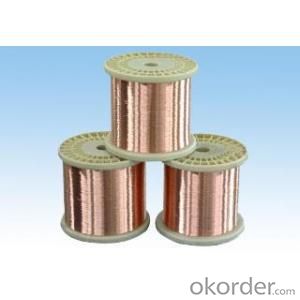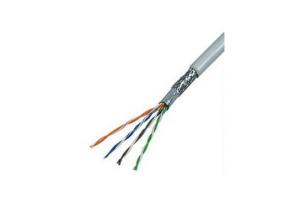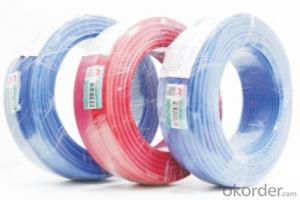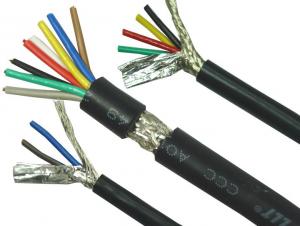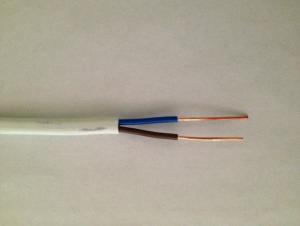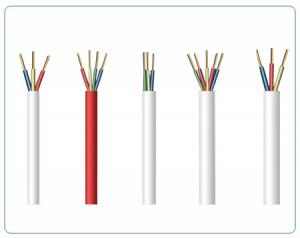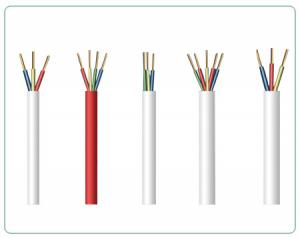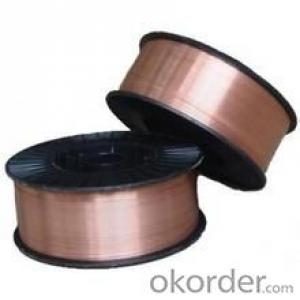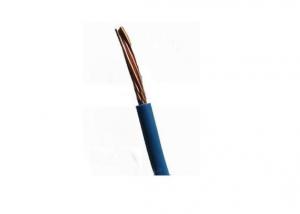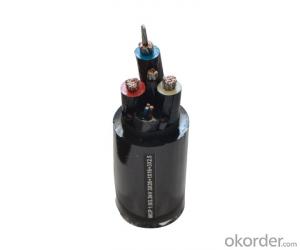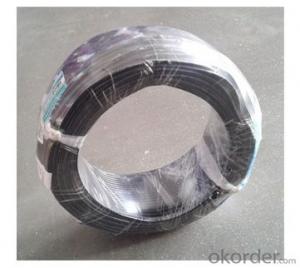Copper Nickel Alloy (CuNi1~CuNi44) A quality
- Loading Port:
- Shanghai
- Payment Terms:
- TT OR LC
- Min Order Qty:
- 10000 m
- Supply Capability:
- 1000000 m/month
OKorder Service Pledge
OKorder Financial Service
You Might Also Like
Copper-nickel alloy wire resistance is low, is widely used in low-voltage electrical appliances, electrical machines, wound resistors, instrumentation and other fields
Wire: Dia 0.04mm-8.0mm
Ribbon/strip: Thickness: 0.04mm-0.75mm
Width: 0.08mm-6.0mm
1) Features:
Our products have the following features: Stable performance, high resistivity, high working temperature, allowable high surface load, small specific gravity and reasonable price.
We can also supply other products by processing on your order: Stranded wire, twisted wire, coiled wire, wave-shaped wires and different kinds of standard or non-standard electrical heating elements.
2) Product Specifications:
Ferro-Chrome Alloys (Ferritic Alloys):
OCr21AL4, OCr21AL6, OCr25AL5, OCr23AL5, 1Cr13AL4, OCr21AL6Nb, OCr27AL7Mo2.
Nickel-Chrome Alloys (Ni-Cu Alloys): Cr20Ni80, Cr15Ni60, Cr30Ni70, Cr20Ni30
Constantan Alloys (Cu-Ni Alloys): CuNi1, CuNi2, CuNi6, CuNi8, CuNi10, CuNi14, CuNi19, CuNi23, CuNi30, CuNi44, Manganin.
3) Competitive price:
Lower costs on labor, lower cost on raw material, high facility availability, short producing cycle, low manufacturing cost, strong adaptive capacity to producing variation
| Properties/ Material | Resistivity | Max.working temperature | Tensile strength | Melting point | Density | TCR | EMF vs Cu |
| ( 20 0 C μΩ.m) | ( 0 C ) | ( Mpa ) | ( 0 C ) | ( g/cm 3 ) | x10 -6 / 0 C | (μV/ 0 C) | |
| (20~600 0 C) | (0~100 0 C) | ||||||
| NC003 | 0.03 | 200 | 210 | 1085 | 8.9 | <100< td=""> | -8 |
| (CuNi1) | |||||||
| NC005 | 0.05 | 200 | 220 | 1090 | 8.9 | <120< td=""> | -12 |
| (CuNi2) | |||||||
| NC010 | 0.1 | 220 | 250 | 1095 | 8.9 | <60< td=""> | -18 |
| (CuNi6) | |||||||
| NC012 | 0.12 | 250 | 270 | 1097 | 8.9 | <57< td=""> | -22 |
| (CuNi8) | |||||||
| NC015 | 0.15 | 250 | 290 | 1100 | 8.9 | <50< td=""> | -25 |
| (CuNi10) | |||||||
| NC020 | 0.2 | 300 | 310 | 1115 | 8.9 | <30< td=""> | -28 |
| (CuNi14) | |||||||
| NC025 | 0.25 | 300 | 340 | 1135 | 8.9 | <25< td=""> | -32 |
| (CuNi19) | |||||||
| NC030 | 0.3 | 300 | 350 | 1150 | 8.9 | <16< td=""> | -34 |
| (CuNi23) | |||||||
| NC035 | 0.35 | 350 | 400 | 1170 | 8.9 | <10< td=""> | -37 |
| (CuNi30) | |||||||
| NC040 | 0.4 | 350 | 400 | 1180 | 8.9 | 0 | -39 |
| (CuNi34) | |||||||
| NC050 | 0.5 | 400 | 420 | 1200 | 8.9 | <-6< td=""> | -43 |
- Q: component of electrical wiring system according the appropriate street light. the voltage power supply and herzt(hz) using for street light.
- That product runs on 12 volts direct current (VDC). A standard receptacle is AC. A standard receptacle in the U.S. is 120 volts, AC. A standard receptacle in the UK is approximately twice that voltage, and is AC. You will need a transformer/rectifier to convert the AC of your countries voltage to 12 VDC DC. The product uses 60 watt bulbs. This means that they will each need 5 amps. The product has 8 bulbs. This means that you will need a total of 40 amps. Therefore, you need to buy a transformer/rectifier that plugs into a standard receptacle and produces at least 40 amps of 12 VDC power. After you buy one, connect it to the cable that comes with the product.
- Q: Wire in the blue line, green yellow line, gray line on behalf of what does this mean?
- AV cable can be connected to the set-top box is not only two-way port? If the signal is not good to persuade you to buy a adapter,
- Q: Electrical wire can be supplied spooled, or kirked, What is 'kirking' and where does the term originate?
- That's a new one on me. It seems to mean wrapping into a long bundle without using a spool. I've done that with wire lots of times but never knew it had a name! As for it's origins, who knows. I'd guess it's an old sailors' term for a way of wrapping up a rope.
- Q: What are the test requirements for the power cord?
- 3 generally showing yellow-red,, blue phase line represents zero, represents the yellow-green ground.
- Q: I have installed ceiling fans before with no problems until now. I just moved into this old duplex where the ac is crap and it's hot as balls outside. I finally break down and get a ceiling fan to install. So I get up to the light fixture,pop it off and to my surprise there aren't enough wires. There are four wires coming from two lines,both sets are black and white. The black wire from one line is connected to the light and the white wire from the other line is also connected to the light. And then the other black and white wires from the seperate lines are connected together. And oh I almost forgot there is no ground wire in sight. What do I do here???
- This Site Might Help You. RE: No ground in old electrical wiring?? I have installed ceiling fans before with no problems until now. I just moved into this old duplex where the ac is crap and it's hot as balls outside. I finally break down and get a ceiling fan to install. So I get up to the light fixture,pop it off and to my surprise there aren't enough
- Q: I am running a new 15 amp breaker to 2 new outlets. I wired the first outlet black to brass, white to silver and bare copper to the green screw in the metal box. I then took a new length of wire and connected to my first outlet bottom screws the same way white to silver black to brass an bare copper to the other green screw in the box. then ran the wire to the second outlet and connected it the same way as the other. when i hook up the breaker and restore power the breaker trips. i don't know what i have done wrong Someone please help
- unhook the second out let, test it I noticed you hooked the bare wire to the green screw in the breaker box, your grounding the out let put it on the silver bar, with the white wire
- Q: I am trying to wire up a tree light. All that comes out of the light is a Black White, and Ground wire. The instructions say you are supposedddd to install a Conduit and conduit connector which i dont have or really know what is. Can i install it without one. (AKA could i just splice it to a cut extension chord that also has a white black and ground?
- No, it's never ok to cut an extension cord and splice it into a light especially without a raintight junction box on an outdoor circuit. The only way that you could safely install this without conduit would be to connect a junction box to the nipple on the light in a manner that would provide a watertight seal, then to connect UF wire to the junction box using a similarly raintight connector and run that wire along a path that would not put it at risk for damage by foot traffic, pets, or landscaping equipment to an existing power source or electric panel, then connecting the UF wire to that box using a raintight connector and connecting the hot, neutral ground, and earth ground wires to the correct wires or terminals in that box. However since you don't know what conduit is, I would strongly urge you to not take this project on yourself. You're dealing with line voltage outdoors in your yard and that's a risky situation. You or someone that you live with or your pet could get electrocuted (as in dead kaput goner) when moisture is present in your back yard. If you need to light a tree, you might consider just one or two of those $5 floodlights with the plastic stake that you stick into the ground and then run an extension cord to. The type of light that you have is made to be hard wired by an experienced electrical professional.
- Q: Does anyone have a link/website that shows which size/color wire nut to use for connecting different guage size wires?What should I be looking out for when screwing on the nut to the wires. Is there anything that I will notice when I have found the correct size?Is the color of the nut standard from one manufacture to another?thanks
- You taped the stripped ends with tape - then installed the nut over the tape? That isn't a good idea - wire nuts have a spiral metal coil inside that assist in making and maintaining a good electrical connection. Electrical tape doesn't do that. I bet you were using either the cheap wire nuts that came with the new fixture, or were using improperly sized wire nuts. I suggest purchasing properly sized wire nuts and remaking the connections properly. RE Additional Details: I would question the reputable websites. First, code does not recognize tape as a device to make eletrical connections, only as a means of insulating a splice. In the old days, taped connections were soldered first to create a good mechanical and electrical connection; the tape was for insulation only. We still use listed wire connectors today that require a tape overwrap for insulating purposes. Second, while taping over a wire nut is not prohibited, the wire nut is the connecting device and must go on the wires first, per all manufacturer's directions.
- Q: What is the difference between RVS and RYS wires?
- ZR indicates flame retardant. KVV PVC insulated control cable Uses: electrical, instrumentation, power distribution device signal transmission, control, measurement. KVVP: PVC sheathed shielded cable Use: electrical, instrumentation, power distribution device signal transmission, control, measurement. RVV (227IEC52 / 53) PVC insulated flexible cable Uses: household appliances, small power tools, instrumentation and power lighting.
- Q: Basically I've got 1 ceiling light in the hallway but I want two. How do I split the 3 wires from the Original light to get them to connect to the 2nd light. I have the relevant wire just no idea how to split
- Without training and experience, with someone who actually knows how to do this stuff, you cannot safely and properly do what you're asking. There are literally dozens of different things you need to know, including what the existing wires are connected to, whether they were done properly, how to make sure the circuit is dead (assuming you don't want to find out the hard way), what size and type of wire you need, how to cut and strip the wires properly, how to install and fasten the new wiring in place, what kind of box and clamps you need, what size wire nuts, how much wire to leave sticking out, not to mention whether you need a permit and inspection for your work and whether your fire insurance will actually still cover you if something goes wrong
Send your message to us
Copper Nickel Alloy (CuNi1~CuNi44) A quality
- Loading Port:
- Shanghai
- Payment Terms:
- TT OR LC
- Min Order Qty:
- 10000 m
- Supply Capability:
- 1000000 m/month
OKorder Service Pledge
OKorder Financial Service
Similar products
Hot products
Hot Searches
Related keywords

